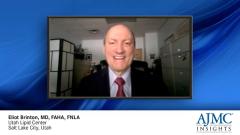
Role of LDL-C Apheresis in Treatment of HoFH
Drs Brinton and Michos highlight LDL-C apheresis in the treatment landscape for homozygous familial hypercholesterolemia [HoFH].
Episodes in this series

Eliot Brinton, MD: What do we do if the standard treatments don’t work? We’re out of the generics. We’re out of the moderately priced branded products. We’re now in much higher-priced territory. And as an apheresis director, I personally prefer to start with apheresis. The reason is that it’s relatively inexpensive compared to the 2 medications that are specifically for HoFH [homozygous familial hypercholesterolemia]. But it is a logistical burden on the patient. The patient needs to come in every 2 weeks or so. There’s some flexibility there, but they have to come into your center with some regularity. They have to spend 3 or 4 hours sitting in a chair while you run their blood through a machine. You have to have venous access, which involves a needle stick. And depending on where the venous access is, they have to hold pretty still. It’s quite a bit of burden on the part of the patient, but understand that they know the burden of the disease, the comorbidities that occur, and the results of their disease. Either they know they’re high risk, or they’ve already had them. So they tend to be motivated patients.
I suggest that when we are considering apheresis, we try to pitch this in a positive way to the patient. If we tell the patient, Mr Jones, there is no way you want to apheresis, it’s not available here. Of course, you don’t want it. And then they say, “No.” Then you can go onto the medications, which is fine. But we want to tell the patients that with exception of Alaska and Hawaii, all 48 of the continental states have access. In some places, they have to travel 5 to 8 hours just to do it out here in the west. But we have patients that do that trip regularly. The trip is not by itself a deal breaker, but the patient has to cooperate, and they have to be willing. And for some patients, it just can’t happen. I’m amenable to the fact that it doesn’t always work. But because it is quite inexpensive, I like to start with that. Also, the other thing is, we’ve had apheresis now really if we’re going back. Fifty years is when it was first experimented with. There are some pretty good data sets going back 20 and 25 years. And with quite an accumulation of data, we can say that there is a large benefit. We’re talking about prevention of 50%, 70%, and 80% of the events that can be prevented by doing apheresis on a regular basis. That is a massive drop in events, and it’s very effective.
What about affordability? No one can afford to pay cash for apheresis. It has to be done with payer cooperation. Thankfully, there are people who do this for a living. If I’m going to put a patient on apheresis, I send some information off to some people whose job it is to get the payer to say yes. And pretty much always the payer says yes. I’ve not had a case where the payer said no. We sometimes have to give a fair amount of paperwork. But these people actually do the acquisition of the approval, and that’s much easier. You have to have payer approval before you go ahead. But payer approval, believe it or not, even though it’s quite expensive, is basically always there for the patient who needs it. And then you make sure that it’s working, and you work through the access issues. Sometimes patients need a vein, so their arms are fine. Sometimes they have a fistula for whatever reason. AV [arteriovenous] fistulas are great, although they’re pretty hard to put in, and they’re kind of obtrusive or intrusive for the patient’s lifestyle. Then you’ve got central ports. These are relatively new. Their ports are basically covered by skin, so there’s basically no risk of infection. Those need a placement, but the placement is quick and painless—nonsurgical. They can do whatever they want to in their life with these ports in place. It’s very easy for us to get access, and the apheresis actually runs a little quicker. With those logistics in place, and if the patient says yes, then we can go ahead and do it. And we can always stop apheresis if we want to, either temporarily or permanently, if that is the best thing for the patient. But I like apheresis because of its excellent track record over time. One of the things that is worth noting is that oftentimes you see improvement in symptoms immediately. At the end of that 2-, 3-, 4-hour procedure, the patient feels better. Why is that? Blood viscosity goes down. There are a lot of immediate factors that are relieved. There is an improvement in vasodilation in the heart. You don’t have to wait very long to actually feel benefit physically. The drop in LDL [low-density lipoprotein] is immediate. It’s usually in the neighborhood of a 60% to 85% drop. It’ll come back up which is why you have to go back and do it again. But apheresis as cumbersome as it is, as intrusive and invasive as it is, is often a very, very good step for these patients who did not respond to the standard therapy.
Erin Michos, MD, MHS: I should mention a little bit more about the background oral medications and HoFH and their limitations. While statins are always our foundation, or lipid-lowering therapy, statins only deliver a modest reduction of LDL in the range of 10% to 25% in individuals who have HoFH because they don’t have functional LDL receptors. But they do benefit often from some stat therapy, likely because it inhibits cholesterol synthesis. Even in individuals who don’t have adequate LDL receptors. The addition of acetamide can also offer some LDL lowering in the range of 10% to 15%. But we are talking about targets for LDL if patients and adults already have atherosclerotic cardiovascular disease and FH [familial hypercholesterolemia]. Our LDL target is you know less than 55, or as low as possible, and it could be really challenging to get HoFH patients down to this range. In the pediatric population, the goal is to try to aim for an LDL of less than 130. So lipid apheresis is FDA-approved in both adults and children for the treatment of HoFH. Lipid apheresis is effective. You can anticipate an average LDL reduction of about 80% after a single treatment. But typically, you have to keep repeating the treatment because the genetic abnormality is still there and the cholesterol levels will rise again after a therapy is completed. It’s usually performed every 1 to 2 weeks. Although the frequency can be adjusted based on a person’s goal LDL and how effective the other background medications are doing to control the LDL.
Generally, it’s very safe. Lipid apheresis might have an overall adverse effect rate of about 11%, but in most of these reactions adverse effects are pretty mild. They can include some bleeding, patients could feel nauseated, vomiting, and hypoglycemia or hypotension. You want to sort of avoid ACE [angiotensin-converting enzyme] inhibitors because of some of the absorption issues with the technology. So you’d want to stop the ACE inhibitor about 24 hours before the procedure of patients on them or use ARBs [angiotensin receptor blockers] instead and heparin is in the platform, so there is a concern for patients who have heparin-induced thrombocytopenia.
Now, children, there’s a whole other set of challenges. In children with HoFH, you recommend having lipid apheresis as young as 7 years of age because I mentioned they can have cardiovascular events, starting at age 8 or even as a teenager. So we want to start early. But especially when you’re talking about really young kids being as peripheral punctures can be challenging. Kids have small vessels and they’re [full of] anxiety, [so it] can be challenging to get me this access in young children, and then sometimes, in some cases, central catheters are placed for easier access, but of course, you have to make sure. There’s always the risk of infection anytime you have an indwelling catheter. And then apheresis sites are not always accessible. Many patients have to travel great distances to get to a center. The Family Heart Foundation is a good resource that has a list on its website by state of where all the lipid-free centers are. But some patients live in rural populations away from these urban academic medical centers and it can be challenging to come in and get treatment.
Transcript edited for clarity.
Newsletter
Stay ahead of policy, cost, and value—subscribe to AJMC for expert insights at the intersection of clinical care and health economics.










































